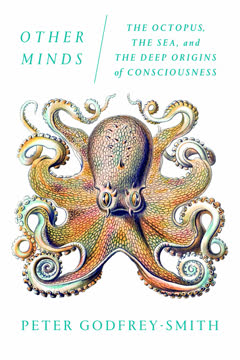मुख्य निष्कर्ष
1. समुद्र: जटिल जीवन और चेतना की जन्मभूमि
"मन का विकास समुद्र में हुआ। पानी ने इसे संभव बनाया। जीवन की उत्पत्ति, जानवरों का जन्म, तंत्रिका तंत्र और मस्तिष्क का विकास, और जटिल शरीरों का आना—all ये सब प्रारंभिक चरण समुद्र में ही हुए।"
जटिलता की उत्पत्ति। समुद्र केवल जीवन के उद्भव का पृष्ठभूमि नहीं था, बल्कि एक सक्रिय वातावरण था जिसने अद्भुत परिवर्तन संभव किए। समुद्र की रासायनिक गतिशीलता, तरल गतिशीलता और प्रचुर संसाधन जीवन की जटिलता को विकसित करने के लिए अनूठे अवसर प्रदान करते हैं।
समुद्री विकास के मुख्य तथ्य:
- एककोशिकीय जीवों ने सबसे पहले परिष्कृत रासायनिक संचार विकसित किया
- प्रारंभिक बहुकोशिकीय जीवन कोशिकाओं के सहयोग से उभरा
- पानी की विशेषताएं जटिल आणविक आदान-प्रदान और संकेतों को संभव बनाती हैं
रूपकात्मक महत्व। समुद्र केवल एक भौतिक स्थान नहीं, बल्कि निरंतर संवाद, अनुकूलन और संभावनाओं का गतिशील तंत्र है, जो जटिलता और चेतना के विकास की प्रक्रियाओं का प्रतिबिंब है।
2. विकास की शाखाएँ: एककोशिकीय से जटिल जीवों तक
"जानवरों का इतिहास एक पेड़ की तरह है। एक 'मूल' से अनेक शाखाएं निकलती हैं, जैसे-जैसे हम समय में आगे बढ़ते हैं।"
विकास की विविधता। जीवन की प्रगति रैखिक नहीं, बल्कि जटिल और शाखित प्रक्रिया है जहाँ प्रजातियाँ विभाजित होती हैं, अलग-अलग विकासात्मक रणनीतियाँ अपनाती हैं। हर शाखा जीवित रहने और अनुकूलन का एक अनूठा प्रयोग है।
विकासात्मक रणनीतियाँ:
- बहुकोशिकीयता कोशिकाओं के सहयोग और विशेषज्ञता से उभरी
- विभिन्न शरीर योजनाओं (जैसे बिलैटरियन) ने नए व्यवहारिक अवसर दिए
- पर्यावरणीय दबावों ने संवेदी और क्रियात्मक नवाचारों को प्रेरित किया
विकास की अनिश्चितता। हर शाखा संभावनाओं का क्षण है, जहाँ सूक्ष्म परिवर्तन भिन्न परिणाम ला सकते हैं, जो विकास की रचनात्मक और आकस्मिक प्रकृति को दर्शाता है।
3. सेफालोपोड्स के असाधारण तंत्रिका तंत्र
"सेफालोपोड्स अकशेरुकी जीवों के समुद्र में मानसिक जटिलता का एक द्वीप हैं।"
विशिष्ट तंत्रिका संरचना। सेफालोपोड्स ने कशेरुकी जीवों से बिलकुल अलग तंत्रिका तंत्र विकसित किया, जिसमें तंत्रिकाएं उनके शरीर, विशेषकर भुजाओं में फैली हुई हैं, जिससे विकेंद्रीकृत बुद्धिमत्ता उत्पन्न होती है।
तंत्रिका नवाचार:
- ऑक्टोपस के पास 500 मिलियन तंत्रिकाएं होती हैं, जो कुछ स्तनधारियों के बराबर हैं
- भुजाएं आंशिक रूप से स्वतंत्र रूप से कार्य कर सकती हैं, स्थानीय निर्णय क्षमता के साथ
- तंत्रिका तंत्र के फैलाव से शरीर में असाधारण लचीलापन और अनुकूलनशीलता आती है
समानांतर बुद्धिमत्ता। सेफालोपोड्स एक स्वतंत्र विकासात्मक प्रयोग हैं जो दिखाते हैं कि बुद्धिमत्ता विभिन्न जैविक मार्गों से उभर सकती है।
4. ऑक्टोपस: कशेरुकी कल्पना से परे बुद्धिमत्ता
"यह शायद सबसे करीब है जहाँ हम एक बुद्धिमान एलियन से मिल सकते हैं।"
असाधारण शरीर संरचना। ऑक्टोपस पारंपरिक बुद्धिमत्ता की समझ को चुनौती देते हैं क्योंकि उनका शरीर लगभग कोई निश्चित आकार नहीं रखता, जिससे अभूतपूर्व व्यवहारिक लचीलापन और समस्या समाधान संभव होता है।
संज्ञानात्मक क्षमताएँ:
- वे व्यक्तिगत मनुष्यों को पहचान सकते हैं
- जिज्ञासा और अन्वेषणात्मक व्यवहार दिखाते हैं
- जटिल उपकरणों का उपयोग और पर्यावरणीय नियंत्रण कर सकते हैं
दार्शनिक अर्थ। ऑक्टोपस यह दर्शाते हैं कि बुद्धिमत्ता केवल मस्तिष्क-केंद्रित, कशेरुकी जैसी संरचनाओं तक सीमित नहीं है, बल्कि पूरी तरह भिन्न शारीरिक संगठन से भी उभर सकती है।
5. विषयगत अनुभव की रहस्यमय उत्पत्ति
"विषयगत अनुभव सबसे मूलभूत घटना है जिसे समझना आवश्यक है, वह तथ्य कि जीवन हमारे लिए कुछ महसूस करता है।"
चेतना का उद्भव। चेतना संभवतः धीरे-धीरे विकसित हुई, जहाँ प्रारंभिक विषयगत अनुभव सरल जीवों में बुनियादी संवेदी और क्रियात्मक क्षमताओं से उभरे।
विकासात्मक प्रगति:
- दर्द और बुनियादी संवेदी अनुभव जटिल चेतना से पहले हो सकते हैं
- विभिन्न पशु वंशों ने स्वतंत्र रूप से विषयगत अनुभव विकसित किया होगा
- चेतना तंत्रिका तंत्र की बढ़ती जटिलता के साथ उभरी
दार्शनिक चुनौती। चेतना को समझने के लिए द्विआधारी सोच से परे जाना होगा, इसे विभिन्न जीवन रूपों में अनुभवों के एक स्पेक्ट्रम के रूप में देखना होगा।
6. सेफालोपोड्स में रंग, छुपाव और संचार
"इन जीवों ने मेरे दार्शनिक प्रश्नों के रास्ते को आकार दिया; समुद्र में उनका अनुसरण करना, यह समझने की कोशिश करना कि वे क्या कर रहे हैं, मेरी यात्रा का एक महत्वपूर्ण हिस्सा बन गया।"
परिष्कृत त्वचा गतिशीलता। सेफालोपोड्स में रंग और पैटर्न तेजी से बदलने की असाधारण क्षमता होती है, जो केवल छुपाव से कहीं अधिक कार्य करती है।
रंग संचार के तरीके:
- लाखों रंग नियंत्रित करने वाली कोशिकाएं (क्रोमैटोफोर्स)
- पृष्ठभूमि से मेल खाने की अद्भुत क्षमता
- रंगों के माध्यम से जटिल संकेतों की संभावना
अभिव्यक्तिपूर्ण जटिलता। रंग परिवर्तन केवल जीवित रहने की रणनीति नहीं, बल्कि संचार और संभावित भावनात्मक अभिव्यक्ति का माध्यम हो सकते हैं।
7. भाषा, आंतरिक भाषण और संज्ञानात्मक विकास
"भाषा विचारों के आयोजन और संचालन के लिए एक माध्यम प्रदान करती है।"
भाषा एक संज्ञानात्मक तकनीक। आंतरिक भाषण एक शक्तिशाली संज्ञानात्मक उपकरण के रूप में विकसित हुआ, जो सोच को व्यवस्थित करने, योजना बनाने और आत्म-नियंत्रण में मदद करता है।
भाषा के संज्ञानात्मक कार्य:
- जटिल तर्क और समस्या समाधान सक्षम बनाती है
- कार्यकारी नियंत्रण और निर्णय लेने में सहायता करती है
- मानसिक अनुकरण और रणनीतिक सोच की अनुमति देती है
तंत्रिका नवाचार। आंतरिक भाषण एक अद्भुत संज्ञानात्मक अनुकूलन है, जो संचार को बाहरी से आंतरिक प्रक्रिया में बदल देता है।
8. अल्पायु, बुद्धिमान जीवों का विरोधाभास
"यदि आपकी जिंदगी एक या दो साल में खत्म हो जाती है, तो बड़ा तंत्रिका तंत्र बनाने का क्या फायदा?"
विकासात्मक दक्षता। सेफालोपोड्स की छोटी आयु शिकार के खतरे और प्रजनन रणनीतियों से प्रभावित होती है, यह उनकी क्षमता की कमी नहीं है।
आयु निर्धारक:
- शिकारी जोखिम विकासात्मक अनुकूलनों को प्रभावित करते हैं
- तेज प्रजनन छोटी व्यक्तिगत आयु की भरपाई करता है
- विभिन्न पर्यावरणीय परिस्थितियाँ आयु को काफी बदल सकती हैं
जैविक लचीलापन। आयु स्थिर नहीं, बल्कि पर्यावरणीय और विकासात्मक दबावों के अनुसार गतिशील होती है।
9. बुद्धिमत्ता में समानांतर विकासात्मक प्रयोग
"सेफालोपोड्स और बुद्धिमान कशेरुकी मन के विकास में स्वतंत्र प्रयोग हैं।"
समानांतर जटिलता। विभिन्न विकासात्मक वंश स्वतंत्र रूप से जटिल बुद्धिमत्ता विकसित कर सकते हैं, अलग-अलग जैविक मार्गों से।
समानांतर बुद्धिमत्ता विकास:
- कशेरुकी और सेफालोपोड्स ने अलग-अलग मस्तिष्क विकसित किए
- समान संज्ञानात्मक क्षमताएं विभिन्न तंत्रिका संरचनाओं से उभरीं
- बुद्धिमत्ता रैखिक प्रगति नहीं, बल्कि बहुआयामी प्रक्रिया है
दार्शनिक अंतर्दृष्टि। बुद्धिमत्ता कोई पूर्वनिर्धारित मंजिल नहीं, बल्कि संभावनाओं से भरा अन्वेषणात्मक मार्ग है।
10. मनुष्य और ऑक्टोपस: जीवन के वृक्ष में दूर के रिश्तेदार
"जब आप समुद्र में गोता लगाते हैं, तो आप हम सभी की उत्पत्ति में गोता लगा रहे होते हैं।"
साझा विकासात्मक विरासत। विशाल भिन्नताओं के बावजूद, मनुष्य और ऑक्टोपस मूल जीवों के माध्यम से गहरे जैविक संबंध साझा करते हैं।
परस्पर जुड़ा जीवन:
- अंतिम सामान्य पूर्वज लगभग 600 मिलियन वर्ष पहले था
- दोनों वंशों ने स्वतंत्र रूप से जटिल तंत्रिका तंत्र विकसित किए
- मूल जैविक प्रक्रियाएं गहरे विकासात्मक संबंधों को उजागर करती हैं
अस्तित्वगत दृष्टिकोण। दूर के विकासात्मक रिश्तेदारों का अध्ययन जीवन की रचनात्मक क्षमता और अंतर्संबंध की गहरी समझ प्रदान करता है।
अंतिम अपडेट:
FAQ
What's Other Minds about?
- Exploration of consciousness: Other Minds by Peter Godfrey-Smith explores the evolution of consciousness, focusing on cephalopods like octopuses and cuttlefish. It examines their complex behaviors and intelligence despite different evolutionary paths.
- Evolutionary perspective: The book traces the history of animals to their common ancestors, exploring how consciousness evolved over millions of years. This narrative provides a framework for understanding the development of minds in various species.
- Philosophical inquiry: Godfrey-Smith combines philosophy with biology, asking profound questions about the nature of mind and experience. He seeks to understand how sentience arises from biological processes.
Why should I read Other Minds?
- Unique insights into intelligence: The book offers a fresh perspective on intelligence by examining cephalopods, challenging the view that intelligence is exclusive to mammals and birds.
- Engaging narrative style: Godfrey-Smith writes in an accessible manner, making complex scientific concepts understandable. His personal experiences with cephalopods add a captivating element.
- Philosophical depth: Readers interested in consciousness will find thought-provoking discussions. It encourages reflection on what it means to be sentient and how different life forms experience the world.
What are the key takeaways of Other Minds?
- Consciousness is evolutionary: The book emphasizes that consciousness evolved gradually through complex biological processes, highlighting the continuity of life and shared experiences across species.
- Cephalopods as intelligent beings: Godfrey-Smith argues that cephalopods showcase complex behaviors and problem-solving abilities, suggesting a form of sentience distinct from mammals.
- Mind-body connection: The author explores how an organism's body influences its mind, raising questions about how different bodies shape consciousness.
How does Other Minds relate to the philosophy of mind?
- Philosophical exploration: Godfrey-Smith engages with classic philosophical questions about consciousness and subjective experience, bridging philosophical inquiry and scientific understanding.
- Evolutionary approach: The book suggests that understanding the development of minds in different species can inform philosophical discussions about sentience, challenging views focused solely on human consciousness.
- Mind-body relationship: The author examines how cephalopods' physical structure influences their mental experiences, contributing to the discourse on the connection between mind and body.
What role do cephalopods play in understanding consciousness in Other Minds?
- Independent evolution of intelligence: Cephalopods have evolved complex nervous systems and behaviors independently from mammals, making them crucial for studying alternative forms of intelligence.
- Unique sensory experiences: The book highlights how cephalopods perceive and interact with their environment, offering insights into different modes of consciousness.
- Comparative analysis: By comparing cephalopods to other intelligent species, Godfrey-Smith provides a broader context for understanding consciousness.
What are the best quotes from Other Minds and what do they mean?
- “If we can make contact with cephalopods as sentient beings...” This quote underscores the idea that intelligence can arise independently in different evolutionary paths, highlighting cephalopods' uniqueness.
- “The octopus is not a survivor but a second expression...” Godfrey-Smith suggests octopuses represent a parallel evolution of intelligence, emphasizing life's diversity.
- “The history of animals has the shape of a tree.” This metaphor illustrates the branching evolution of species, indicating how different life forms emerged from common ancestors.
How does Peter Godfrey-Smith connect cephalopods to consciousness?
- Evolutionary insights: Godfrey-Smith argues that studying cephalopods provides insights into the evolution of consciousness, reflecting parallel evolutionary paths to those in vertebrates.
- Comparative analysis: He compares cephalopod intelligence to mammals and birds, highlighting similarities and differences in cognitive abilities.
- Philosophical framework: By integrating philosophical discussions, Godfrey-Smith enriches the scientific analysis of cephalopod behavior, emphasizing inner speech and self-awareness.
How does Other Minds challenge traditional views of intelligence?
- Intelligence beyond mammals: Godfrey-Smith argues that intelligence is not limited to mammals and birds, as evidenced by cephalopods' complex behaviors.
- Diverse expressions of intelligence: The book highlights various ways intelligence can manifest, broadening the definition beyond traditional metrics.
- Evolutionary context: By placing cephalopods within an evolutionary framework, Godfrey-Smith illustrates how intelligence can arise independently in different lineages.
What scientific methods does Godfrey-Smith use in Other Minds?
- Comparative analysis: The author examines the evolutionary history of cephalopods alongside other intelligent species, deepening the understanding of consciousness development.
- Philosophical inquiry: Godfrey-Smith integrates philosophical questions with scientific research, exploring cephalopod intelligence's implications for understanding consciousness.
- Field observations: His fieldwork and observations of cephalopod behavior provide empirical evidence to support his arguments.
What evolutionary theories does Other Minds discuss?
- Medawar-Williams Theory: Godfrey-Smith explores this theory of aging, suggesting aging is a byproduct of natural selection, with late-acting mutations leading to age-related decline.
- Convergence and divergence: The book discusses convergent evolution, where different species develop similar traits independently, using cephalopods and vertebrates as examples.
- Cognitive evolution: Understanding cognition's evolution requires examining diverse pathways taken by different species, with cephalopods offering a unique perspective.
How does Godfrey-Smith describe the social behavior of octopuses in Other Minds?
- Complex interactions: Octopuses exhibit complex social behaviors, including aggression, cooperation, and communication, particularly in environments like Octopolis.
- Color change as communication: They use color change to communicate during social interactions, conveying information about intentions and emotional states.
- Ecosystem engineering: Octopuses modify their environment, creating shelters and dens that facilitate social interactions, illustrating their role as ecosystem engineers.
What is the significance of Octopolis in Other Minds?
- Unique habitat: Octopolis is a unique environment where octopuses exhibit social behaviors rarely observed in the wild, allowing for controlled study.
- Ecosystem engineering: The presence of a metal object has led to a shell bed, which octopuses use to create dens, enhancing social interactions and survival.
- Research opportunities: Octopolis provides valuable opportunities for researchers to observe and document octopus behavior, contributing to understanding cephalopod intelligence.
समीक्षाएं
अदर माइंड्स समुद्री जीवों, विशेषकर ऑक्टोपस और कट्टलफिश की बुद्धिमत्ता और चेतना की गहराई में उतरती है। गॉडफ्रे-स्मिथ वैज्ञानिक अवलोकनों को दार्शनिक प्रश्नों के साथ जोड़ते हुए चेतना के विकास की पड़ताल करते हैं। कई पाठकों ने इस पुस्तक को बेहद रोचक पाया, जबकि कुछ को लगा कि कभी-कभी यह विषय से भटक जाती है या ध्यान केंद्रित नहीं रहता। लेखक के ऑक्टोपस और कट्टलफिश के साथ व्यक्तिगत अनुभव पुस्तक में जीवंत किस्से प्रस्तुत करते हैं। यह किताब पाठकों को चुनौती देती है कि वे उन प्राणियों की बुद्धिमत्ता और चेतना की प्रकृति पर विचार करें, जो मनुष्यों से पूरी तरह भिन्न हैं। कुल मिलाकर, यह अद्भुत समुद्री जीवों के मस्तिष्क की गूढ़ समझ प्रदान करती है, जो सोचने पर मजबूर कर देती है।
Similar Books










